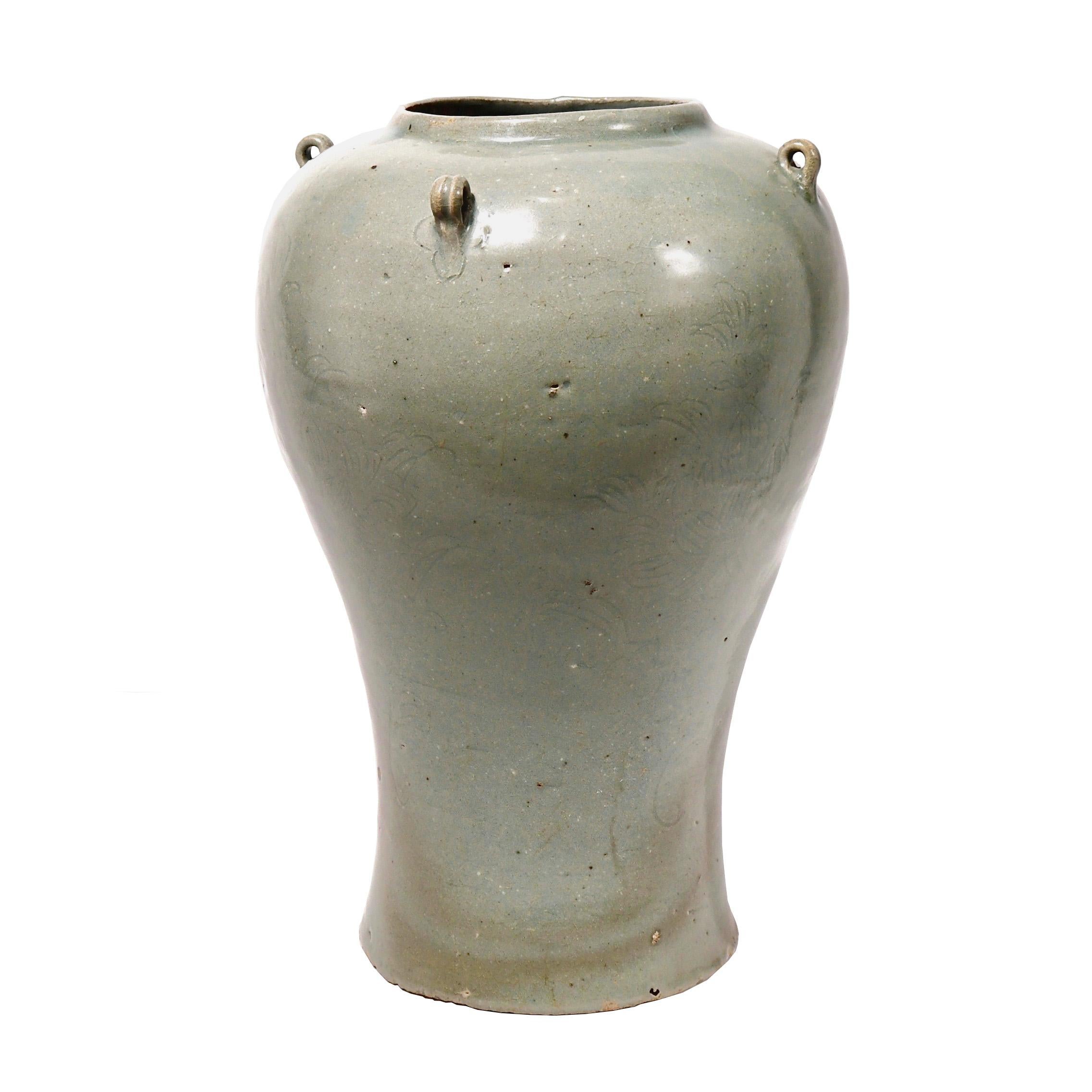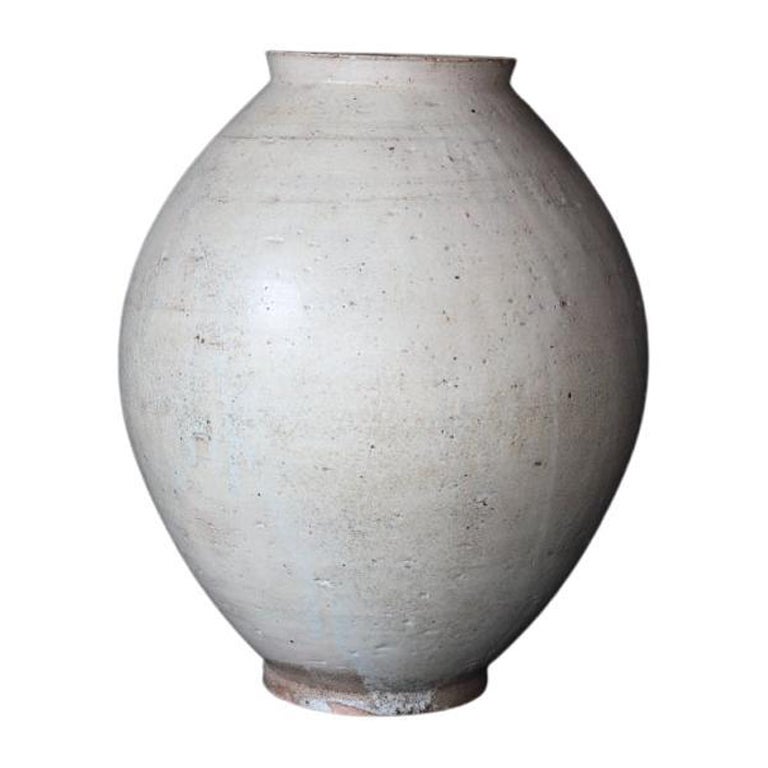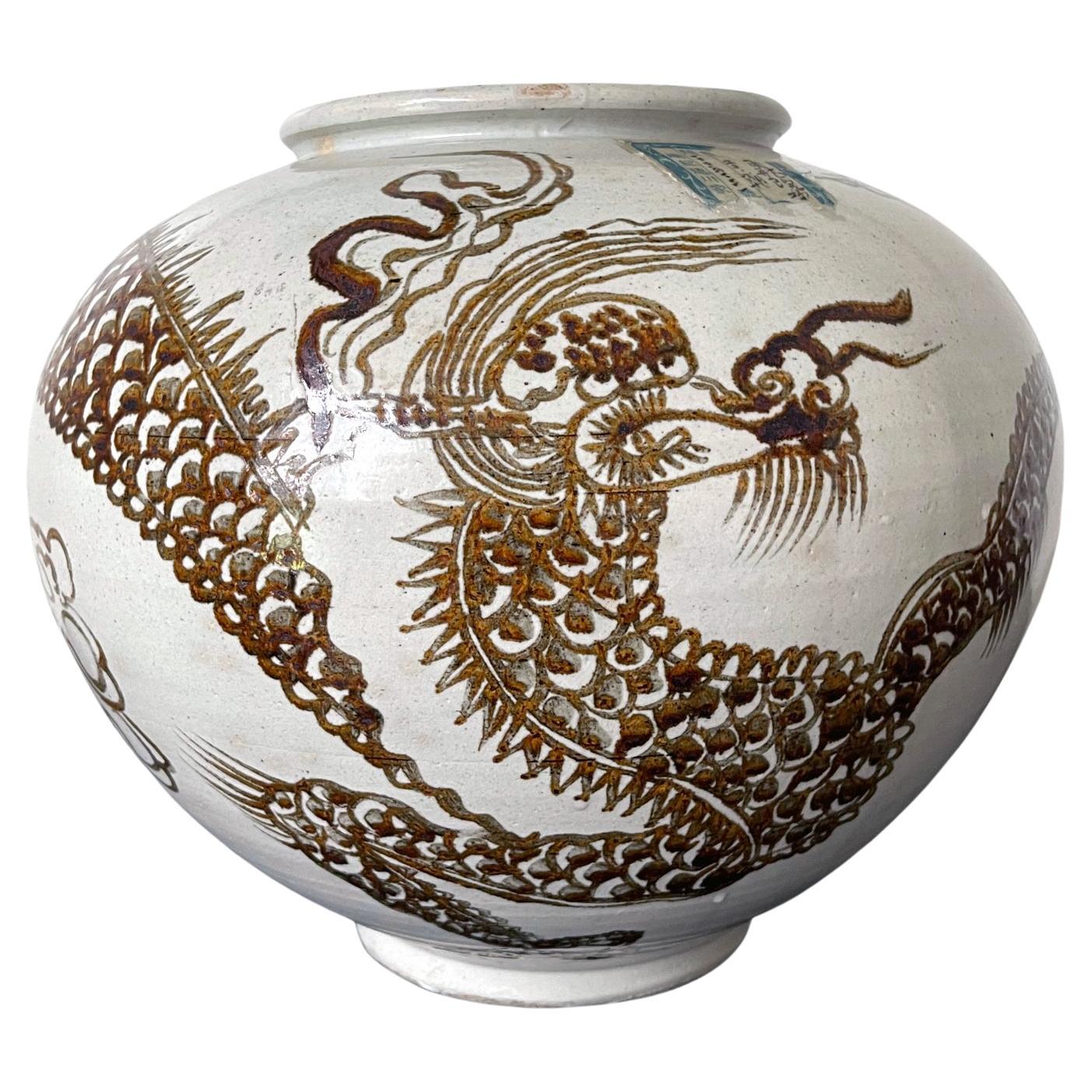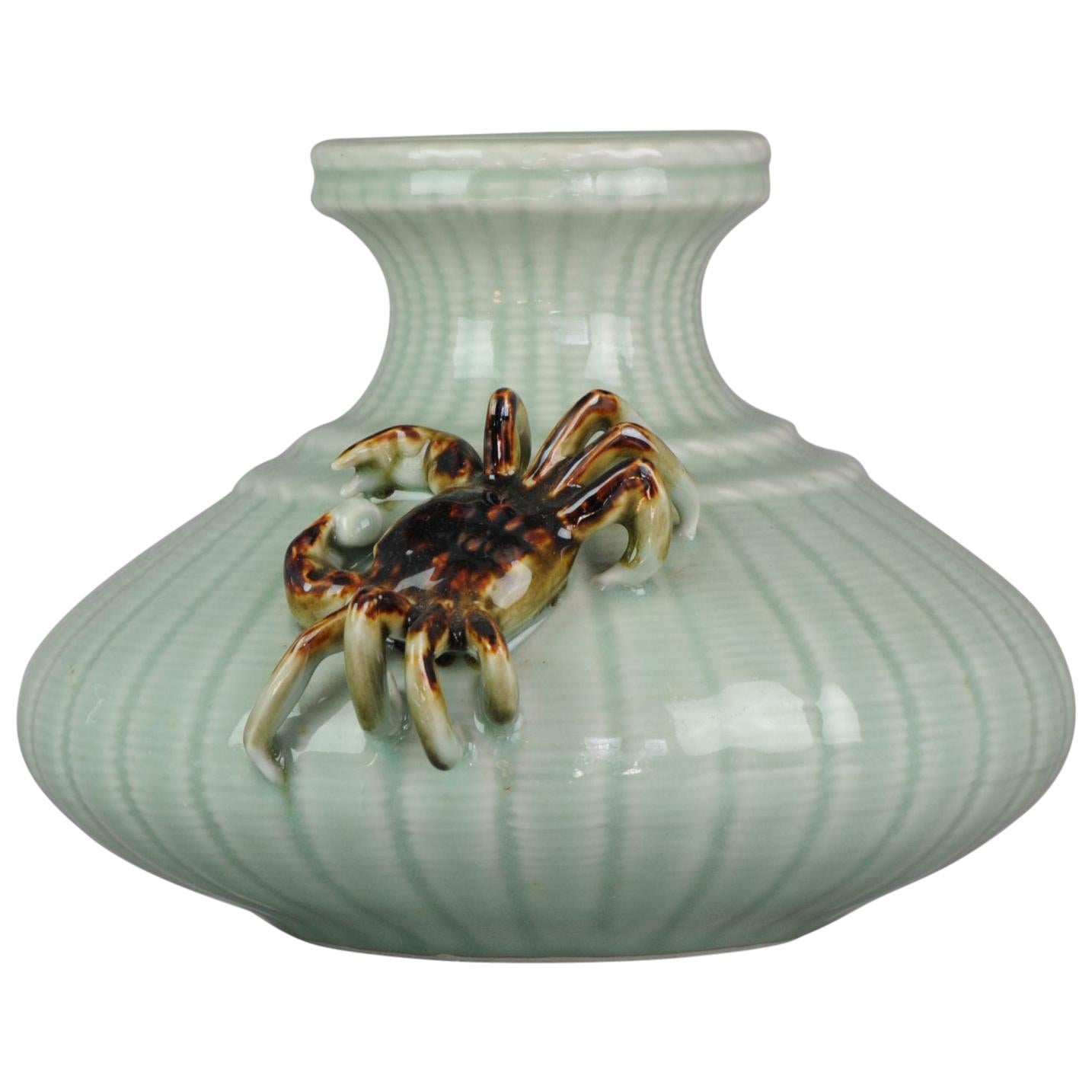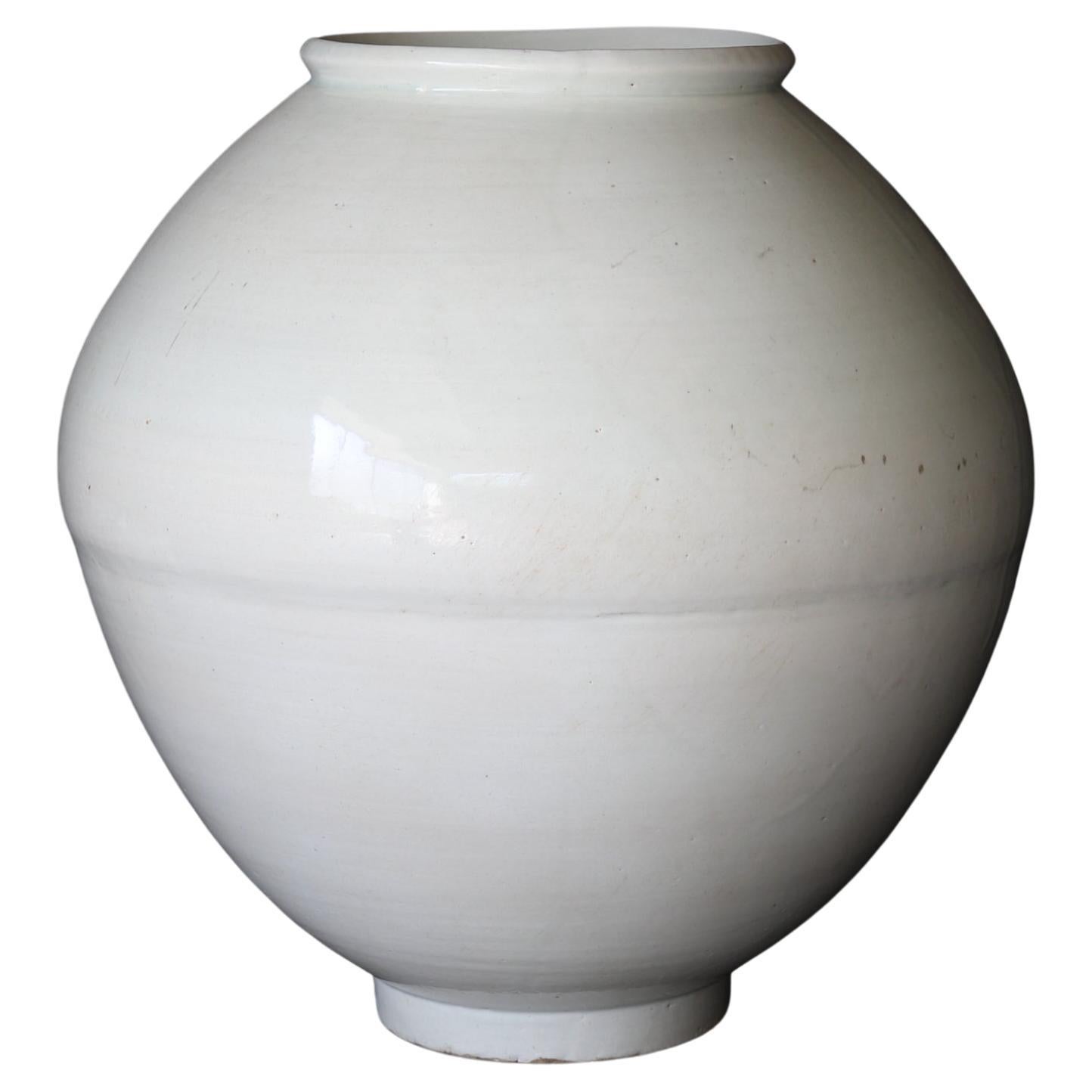Items Similar to Massive Modern Korean Celadon "Thousand Cranes" Moon Jar, 21st Century, Korea
Want more images or videos?
Request additional images or videos from the seller
1 of 11
Massive Modern Korean Celadon "Thousand Cranes" Moon Jar, 21st Century, Korea
About the Item
A large and impressive modern Korean slip inlaid celadon "Thousand Cranes" moon jar attributed to Han Gi Woong, 21st century, South Korea.
The moon jar is decorated all around with carved and slip inlaid images of cranes, and glazed all over with a warm and bright celadon green glaze. The cranes fly in formation, circling the jar in a pleasing pattern, their white bodies and black legs contrasting nicely against each other as well as the celadon ground. The glaze with a subtle and attractive crackle throughout.
The massive jar (16" diameter) of typical moon jar shape, with a globular body set on a short ring foot, and a short narrow neck with rolled mouth rim. Unlike traditional moon jars, this one has been created as a single piece, rather than two hemispheres joined together.
Cranes are symbols of longevity and grace in Korea. The crane is also the symbol of the city of Incheon, where the artist is based. The "Thousand Cranes" motif is a popular motif in Korean ceramics, though it is rarely literal, usually just describing a large number of cranes. In this case however, there literally are one thousand cranes. The cranes are arranged in twenty neat rows of fifty cranes each. The rows of cranes are graduated in size to take into account the curve of the jar, creating a beautiful "S" shape to the columns, giving the jar a sense of motion.
Two character mark on the bottom reading 芸珍 and attributed to the contemporary Korean potter Han Gi Woong.
- Dimensions:Height: 16.25 in (41.28 cm)Diameter: 16 in (40.64 cm)
- Materials and Techniques:
- Place of Origin:
- Period:
- Date of Manufacture:Circa 2010's
- Condition:Wear consistent with age and use. In fine condition. Minor chipping to the foot rim, as seen in photos. No cracks or repairs noted.
- Seller Location:Austin, TX
- Reference Number:1stDibs: LU894739251722
About the Seller
5.0
Gold Seller
These expertly vetted sellers are highly rated and consistently exceed customer expectations.
Established in 2001
1stDibs seller since 2010
305 sales on 1stDibs
Typical response time: 1 hour
- ShippingRetrieving quote...Ships From: Austin, TX
- Return PolicyA return for this item may be initiated within 7 days of delivery.
More From This SellerView All
- Korean Silla Dynasty Footed Jar, circa 6th Century, KoreaLocated in Austin, TXA charming Korean high fired gray pottery stoneware footed vessel, Three Kingdoms Period, Silla Kingdom, circa 6th century. The vessel of traditiona...Category
Antique 15th Century and Earlier Korean Antiquities
MaterialsPottery, Stoneware
- Korean White Glazed Jar, Joseon Dynasty, 18th Century, KoreaLocated in Austin, TXA sublime Korean white glazed porcelain globular jar, Joseon Dynasty, 18th century, Korea. The squat jar is heavily potted, with a globular body, very short neck, and wide mouth r...Category
Antique 18th Century Korean Ceramics
MaterialsPorcelain
- Small Korean White Glazed Porcelain Moon Jar, Joseon Dynasty, 18th/19th CenturyLocated in Austin, TXA subtle and sublime small Korean white glazed porcelain moon jar, Joseon Dynasty, 18th/19th century, Korea. The small moon jar of typical form, ...Category
Antique Early 1800s Ceramics
MaterialsPorcelain
- Korean Goryeo Celadon Glazed Sangam Inlaid Bowl, 12th/13th Century, KoreaLocated in Austin, TXA charming Korean celadon glazed stoneware bowl with white and black sangam inlay, Goryeo Dynasty, 12th - 13th century, Korea. The celadon glazed stoneware bowl of generous propor...Category
Antique 15th Century and Earlier Korean Ceramics
MaterialsStoneware
- Korean Goryeo Celadon Glazed Slip Inlaid Bottle Vase, 12th/13th Century, KoreaLocated in Austin, TXA delightful small Korean Goryeo ware celadon glazed stoneware bottle vase with sangam slip inlay, Goryeo Dynasty, 12th - 13th century, Korea. The sma...Category
Antique 15th Century and Earlier Korean Ceramics
MaterialsStoneware
- Korean Carved Celadon Vase, Maebyeong, Goryeo Style, Early 20th CenturyLocated in Austin, TXA wonderful Korean celadon vase, called a maebyeong, in the Goryeo style, but of early 20th century manufacture. The maebyeong vase with a beaut...Category
Early 20th Century Korean Ceramics
MaterialsStoneware
You May Also Like
- Faceted Korean Ceramic Celadon Jar Joseon DynastyLocated in Atlanta, GAA small ceramic celadon storage jar circa 18th century of Korean Joseon Dynasty. The melon shape jar with a mouth and base of the same size display a beautiful harmony in its form. T...Category
Antique 18th Century Korean Other Ceramics
MaterialsCeramic
- Korean Celadon Jar with Four Handles. Goryeo dynasty, 12th century.Located in Point Richmond, CAKorean Celadon Jar with Four Handles. Goryeo dynasty, 12th century. A stoneware body of baluster form with bulbous high shoulder, four small strap ...Category
Antique 15th Century and Earlier Korean Other Ceramics
MaterialsCeramic, Celadon
- Moon Jar / Korean Antique vase / Joseon Dynasty / 18th CenturyLocated in Kyoto-shi, KyotoIt's a wonderful moon jar. It is a rare size that is suitable for the alcove of a Japanese tea room. It is shaped at once without connecting the uppe...Category
Antique 18th Century Korean Antiquities
MaterialsCeramic
- Korean Ceramic Moon Jar with Dragon Joseon DynastyLocated in Atlanta, GAOn offer is a large Korean ceramic storage jar (hangari) with white glaze and iron red underglaze dragon design. The globular shaped jar derived its form from the Moon Jar of the ear...Category
Antique 18th Century Korean Archaistic Ceramics
MaterialsCeramic
- Moon Jar 'Dalhanari', Lot3 / 17th Century / Korean Antiques / Joseon DynastyLocated in Kyoto-shi, KyotoThis is a white porcelain jar from the mid-Joseon period, also known as a "Talhunari" or "moon jar". During the Joseon Dynasty, which was strongly influenced by Confucianism, the purity of white porcelain was particularly prized in its artistic expression due to its Confucian sensitivity. The defining characteristic of white porcelain during this period was its pure white color, but there were many subtle variations in the white hues, with some being classified as milky white, snowy white, ashen white, and bluish white. The term "Talhunari" means "moon jar" in Korean, and it refers to the large, round shape of the jar, resembling a full moon. It was named by Kim Whanki, a representative abstract painter of Korea. The soft, curving lines and sturdy body that seems to embrace the full moon give the jar both power and tranquility. This type of jar was produced in large quantities during the 17th century. The white of the moon jar is not the pure white of early Joseon porcelain...Category
Antique 17th Century Korean Ceramics
MaterialsCeramic, Porcelain
- Moon Jar 'Dalhanari' - Lot2 / 17th Century / Korean Antiques / Joseon DynastyLocated in Kyoto-shi, KyotoThis is a white porcelain jar from the mid-Joseon period, also known as a "Talhunari" or "moon jar". During the Joseon Dynasty, which was strongly influenced by Confucianism, the purity of white porcelain was particularly prized in its artistic expression due to its Confucian sensitivity. The defining characteristic of white porcelain during this period was its pure white color, but there were many subtle variations in the white hues, with some being classified as milky white, snowy white, ashen white, and bluish white. The term "Talhunari" means "moon jar" in Korean, and it refers to the large, round shape of the jar, resembling a full moon. It was named by Kim Whanki, a representative abstract painter of Korea. The soft, curving lines and sturdy body that seems to embrace the full moon give the jar both power and tranquility. This type of jar was produced in large quantities during the 17th century. The white of the moon jar is not the pure white of early Joseon porcelain...Category
Antique 17th Century Korean Antiquities
MaterialsCeramic, Porcelain
Recently Viewed
View AllMore Ways To Browse
Chinese Porcelain Guanyin
Thai Wash Basin
Vintage Italian Glass And Brass Pendant Light
Original Palmette
Swedish Ceramic Bowl
French Bronze Candlestick Pairs
Set Of Two Cocktail Tables
Pair Units
Mid Century Modern Bar Cart Wood
Door Handle Casted
Vintage Walnut Coffee
Double Consoles
Vintage Italian Brass And Glass Sconces
Small Decorative Jar
Leather Rotating
Collectible Design Armchair
Coffee Tea Cup
4 X 13 Rug

